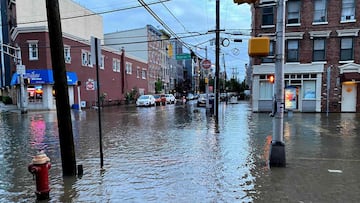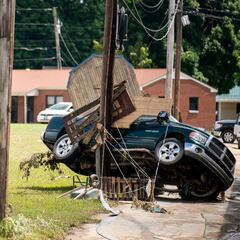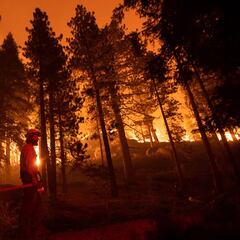How many people have died in the flooding across the North East?
Storm Ida has torn across the north-east, killing at least 41 people. Biden has described the fight against climate change as a "matter of life and death."


The north-east is particularly badly affected
The epicenter of the damage has been across New York and New Jersey, with videos all over the internet showing flooded subways and submerged cars. New York CIty subway is largely closed due to the damage and risk to life.
The majority of the 41 deaths so far have been from people trapped in cars and basements as water levels rose. Both New York and New Jersey have declared states of emergency to help rescue those who are trapped in the destruction.
Rainfall from tropical storm Ida gushing into the New York City subway pic.twitter.com/7wBH5qtM1U
— David Begnaud (@DavidBegnaud) September 2, 2021
In Central Park, an astonishing 3.15 inches of rain fell in just one hour. That compares to the forecast of that level to fall over the whole day.
New York Governor Kathy Hochul said: "We did not know that between 8:50 and 9:50 p.m. last night, that the heavens would literally open up and bring Niagara Falls level of water to the streets of New York."
Other parts of the US have been barraged with extreme weather from Storm Ida. Tornadoes have torn across Louisiana and Mississippi, causing President Biden to travel to the former on Friday.
Truly remarkable time lapse video from our remote cam that was set up in Laplace, LA at Frenier Landing to capture the storm surge from hurricane #Ida @BuzzFeedStorm @afreedma @capitalweather pic.twitter.com/e7b19LXOmb
— Mark Sudduth (@hurricanetrack) August 30, 2021
Politicians decry climate change's effect on the crisis
Much of the extreme weather can be attributed to the climate catastrophe that has seen one of the strangest summer weathers throughout the planet. Europe has witnessed extreme flooding all summer, with huge damage in Germany and floods in Spain as recently as Thursday. The world has been heating up at and increasing rate since the industrial revolution, and politicians are currently making the right noises when it comes to dealing with the problem.
BREAKING: Flooding right now in Short Hills, New Jersey. This is downtown! 😱
— Tena Ezzeddine (@TenaCBSLA) September 2, 2021
Gov. Murphy declares state of emergency due to tropical storm #Ida. #njwx pic.twitter.com/0EWWfqHRpZ
President Biden has been outspoken in his pledge to prevent a climate disaster. Speaking about Storm Ida, the president said, "This destruction is everywhere, it's a matter of life and death and we are all in this together. This is one of the great challenges of our time but I'm confident we will meet it."
Rescuing the climate could already be impossible
Whether these noises will be followed up by concrete action is another question. NASA predicts that the global temperature will rise by between 2.5 and 4.5 degrees by 2100 which will cause untold damage to ecosystems and habitats around the world. Changes in the planet will also increase the frequency of extreme weather like that seen In New York and New Jersey in the last days.
Related stories
The Intergovernmental Panel on Climate Change, a United Nations body, released a report in August that was downbeat on the chances that humanity can turn the climate crisis around. It says that the limits that were supposed to be imposed by the Paris Climate Accord of 1.5 degrees will be smashed at the current rate of CO2 production the world currently makes.
The report also said that people should not kid themselves; we are currently living in a world affected by climate change. The extreme weather is another manifestation of this. The only way that humanity can properly deal with this is radical action and systemic change to the way we live. This includes big business. Data from the Climate Accountability Institute estimates that since 1965, twenty companies have been responsible for a third of CO2 emissions worldwide. With meaningful changes to the way these companies operate, which in the case of oil companies is pretty impossible, can the inevitable change be lessened.

